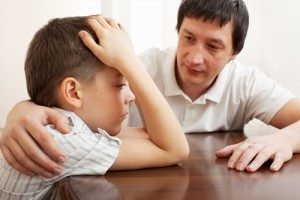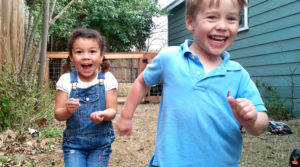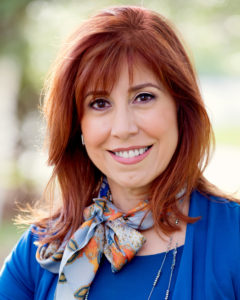 The Beauty of a Fresh Young Mind
The Beauty of a Fresh Young Mind
Your child is born beautiful, both fragile and strong at the same time, with all your hopes and dreams for her waiting to be fulfilled.
She bursts through infancy, preschool, then her first few grades, and you discover she’s not an empty canvas waiting for you to paint…she’s an individual. Her views catch you by surprise, her reactions are different than yours would be. And little by little it dawns on you she’s actually a separate and unique person in her own right… And you learn to observe, support, and guide.
But then, along the way, you notice traits that also trouble you. She’s your precious child, and you want her to enjoy her childhood, her school activities, her friends. But, she seems less and less like the toddler and  preschooler you knew her to be.
preschooler you knew her to be.
She’s sad, irritable, agitated at times.
By the time she’s 13, she’s talking about wanting to die. (And you think, this isn’t typical… is it?) Thirteen years old… and mentions death not just once… but often. She is treated with correction at school much more than she used to, and seems to swing from glee to sorrow to desperation… the correction from teachers baffles and grieves her. Your daughter feels persecuted, and doesn’t understand. She cries that she wants to die… You wonder what on earth is going on…? What are these suicidal thoughts she has?
Why Would a Child Want to Die…?
A 10 year-old-boy reaches out to his parents, weeping, crying out that he wants to die. When they tell him things will get better, he says that they always say that. That he’s given up hope… at 10.
This wasn’t the impulsive thought of a pubescent teenager, but a child who can’t remember a time he wasn’t suffering in emotional pain. That boy later attempts suicide the first time at 14. Again, not impulsively…he’s been suffering for years… Suicidal thoughts in children. Heartbreaking… and dangerous.
Suicide in children under 12 is rare….about 4 per 500,000 a year… at least that’s what statistics say. That figure’s doubled since 1979, and recently was listed as the 14th leading cause of death in children under 12. Just under meningitis and anemia.
If kids under 12 struggle with depression and other mood disorders, and even think about wanting to die, why is the rate of suicide so low among this age?
It’s not because it doesn’t happen. No… it’s because it happens differently.
For instance, one reason is supervision. This age is typically supervised by a parent or teacher. So they’re more often interrupted. And most parents are reluctant to report these cases.
Children are Spontaneous
Another point is that traditional suicide in teenagers and adults starts with a thought, then grows into a plan, then  proceeds to action. On the other hand, suicide in children is typically spontaneous, rather than planned. Like a child overwhelmed from school might jump in front of traffic, and it’s labeled an accident. Or a frustrated third grader “falls” from an apartment window after wrestling with his brother. Again, it looks like an accident. Or a 5 year-old jumps in a pool…then inhales… on purpose. Again, an accident.
proceeds to action. On the other hand, suicide in children is typically spontaneous, rather than planned. Like a child overwhelmed from school might jump in front of traffic, and it’s labeled an accident. Or a frustrated third grader “falls” from an apartment window after wrestling with his brother. Again, it looks like an accident. Or a 5 year-old jumps in a pool…then inhales… on purpose. Again, an accident.
Bottom line, adults often miss depression or anxiety disorders in a young child. Exceptionally tuned-in parents may notice the changes in their child, but may not know what to do to help. It’s a phase… they think. He’s a child. He’ll snap out of it.
But years go by. And “wanting to die” just keeps coming up.
Persistent Sorrow May Be a Sign
An 11-year -old cries herself to sleep night after night…praying she’ll die before she wakes in the morning. But  morning after morning, she wakes up as usual. And each time she’s disappointed, because life is so full of pain for her. She can’t remember when she wasn’t drowning in sorrow, emptiness, isolation.
morning after morning, she wakes up as usual. And each time she’s disappointed, because life is so full of pain for her. She can’t remember when she wasn’t drowning in sorrow, emptiness, isolation.
She always dove into her school work to distract herself from the constant inner ache. The sense of futility. But eventually, she just got tired. Tired of trying so hard, tired of fighting constantly for relief. It all seemed so hopeless. Pointless.
One night, her mom walks into her room to kiss her goodnight, and finds her with a bottle of Tylenol dumped in front of her on the bed, and a tall glass of water in her hand.
Her mom had no idea she felt suicidal…
When you’re faced with suicidal thoughts in children what do you do…?
You Feel So Helpless…
Turns out teenaged girls are twice as likely to be diagnosed with a mood disorder as boys. And boys are also far too often affected by the pain and listlessness that saps their desire to live. The agitation some depressed kids feel often leads to disruption in class, and the child is punished. Which further reduces their hope as well as their self respect.
What do you do? Tighten the discipline…? Then tighten the structure…? Plus, tighten her accountability…?? Unfortunately, all too often what appears to be a discipline problem in a child at school is more accurately a psychiatric mood problem. Not that discipline and structure aren’t good for children. They are. But an ill child may not have the energy to respond as you’d wish…
If the child is depressed, correction and punishment can just drive him further into himself, reducing any hope or self-respect he might have had. If he has another behavior disorder, he likely doesn’t understand what drives him, and just may feel baffled by the punishment, and more hopeless.
hope or self-respect he might have had. If he has another behavior disorder, he likely doesn’t understand what drives him, and just may feel baffled by the punishment, and more hopeless.
Parents Try So Hard to Help
The most well-meaning parents can be completely caught off-guard by a psychiatric mood disorder in their child. Their best efforts to help by encouraging new interests and social activities can be misdirected if the child is depressed, or suffering from an anxiety disorder, that drains her energy.
No matter how closely they may work with the psychiatrist to try new medications, therapies, hospitalizations, exercise and diet changes, if the problem in the child’s brain is not related so much to school and friends and junk food but rather to structural changes in certain parts of the brain, traditional efforts aren’t going to help. And everyone becomes discouraged…and exhausted.
For parents, to know your child is wishing to die… month after month, year after year… and that all your best efforts make no difference… can leave you feeling defeated, but never willing to give up the fight.
And, if you’ve fought for your child’s life for years, and you hear about a treatment that’s bringing relief to others within hours, your instincts leap at the opportunity to save your child.
So you learn all you can about this treatment.
Suicidal Thoughts Children Have – What Can Parents Do?
 Your research shows you there are skeptics, professors and scientists who say there are reasons to wait and see if this remarkable treatment is safe, but you learn of those who have been almost miraculously released from their symptoms, you want to try it. You reach for hope.
Your research shows you there are skeptics, professors and scientists who say there are reasons to wait and see if this remarkable treatment is safe, but you learn of those who have been almost miraculously released from their symptoms, you want to try it. You reach for hope.
You say to yourself, the risks of unknown potential side effects that might show up decades later, compared to saving my child’s life right now, is a no-brainer. Our child may not live till next month… !
We’ll take this as it comes, and help her to get her life back now.
If you’ve ever lived with a suicidal loved one, you know how very real this comparison is. Your instinct says, “Ok, so what if we wait 20 years when researchers know more…? She won’t be alive when that time comes. Let’s give her the time we can.”
That’s the story of those who’ve desperately needed a remedy for their child’s psychiatric mood disorder. Who have almost resigned to accepting their child will die from suicide.
WHAT can be done?
The New Story of Ketamine Treatment
Ketamine treatment is presenting itself as the psychiatric hero for mood disorders. A drug that’s been used in anesthesia for humans and animals for 50 years is showing itself to remarkably restore the lives of those disabled by mood disorders.
A drug that’s been heavily abused on the streets, under the name Special K. Like so many medications that are a  great help to those who need them, and receive them under medically-supervised conditions, ketamine is abused by people “just looking for a good time.”
great help to those who need them, and receive them under medically-supervised conditions, ketamine is abused by people “just looking for a good time.”
Sadly, there are rare and serious long-term side effects that have occurred with illegal, heavy ketamine abuse on the street. Things like severe bladder pain that have sometimes required the removal of the bladder, for instance. But, keep in mind the doses that people have used illegally to get to this point are massive … each one on the order of 10 times or more the dosage used in anesthesia, over years. And the dose used in psychiatry is miniscule in comparison. We call it a fairy dust fraction.
Ketamine Treatment – To Be Provided Only Under Close Medical Supervision
Under medically-supervised conditions, ketamine treatment has proven to be a safe medication for decades in children and adults. Children and adults have responded well to it in ERs and ORs throughout the country for decades.
The uncertainty lies in the fact that, as an anesthetic, it’s not been used repeatedly in many patients over a period of years, so there is limited information about whether there might be long-term negative side effects.
But, as a psychiatric treatment for depression, anxiety, and other mood disorders, IV ketamine treatment is being used now with wonderful results. While it’s true that a single dose of ketamine may not last very long, a short series of infusions often brings about a complete remission of symptoms. In our practice, with our customized treatment protocols, fewer than 20% of our patients need to return for follow-up or maintenance infusions.
And while these carefully supervised infusions are rather expensive, most parents say that the investment is less than the cost of antidepressants over years…that haven’t worked…not to mention the value of watching their child bloom.
Suicidal Thoughts Children Have Can Be Dissipated by Ketamine Treatment …in Minutes
Plus, a remarkable and separate action of IV ketamine, is that it erases suicidal thinking within 4 hours, and often  in minutes.
in minutes.
So it not only removes the danger of suicide, but also gives your child back her joy for life. The power to enjoy experiences. Plus, initiative to work through therapy to strengthen her thinking patterns for productive living. And, the hope to plan for and work toward the future.
Yale Psychiatrist Touts Ketamine Treatment in Children
Jack Turban MD, a child and adolescent resident psychiatrist at MGH/Harvard Medical School, recently published an article where he shared his observations of a group of adolescents during and after their IV ketamine infusions for psychiatric mood disorders. After their infusions, he remarked:
“I could see the weight of depression lifted from these patients within hours. Adolescents who were previously ready to end their own lives became bright and hopeful. Psychiatry has never seen a drug intervention so powerful and fast acting. While most anti-depressants take weeks to work and offer modest improvement, ketamine offers dramatic improvement in less than a day.”
own lives became bright and hopeful. Psychiatry has never seen a drug intervention so powerful and fast acting. While most anti-depressants take weeks to work and offer modest improvement, ketamine offers dramatic improvement in less than a day.”
Dr. Turban went on to express his concern that some doctors are using less discretion with ketamine treatment — in fact, he questioned their ethics. He described doctors who were sending large amounts of the drug home with patients, to give themselves injections at home. This puts the patient in jeopardy of side effects or a situation that can’t be handled at home. He also spoke of lollipops for children, and the danger of addiction under such uncontrolled use.
Dr. Turban quoted Jennifer Dwyer, MD PhD at the the Child Study Center at Yale, who said,
“Ketamine should only be given under careful physician supervision with appropriate monitoring.”
We agree.
IV Ketamine Treatment – Innovative Remedy for Psychiatric Mood Disorders
With that understanding, we at Innovative Psychiatry are consistently encouraged by the hope and promise that IV  ketamine is providing for recovery and remission of psychiatric mood disorders in children and adolescents, as well as adults. We operate with integrity and with excellence, and use only the best practices in providing IV ketamine treatment for treatment-resistant mood disorders.
ketamine is providing for recovery and remission of psychiatric mood disorders in children and adolescents, as well as adults. We operate with integrity and with excellence, and use only the best practices in providing IV ketamine treatment for treatment-resistant mood disorders.
So, we proceed with great care, following the results of clinical studies and data across the country to watch new advances unfold.
We’re on the edge of our seats because suicide is the second leading cause of death in adolescents, and 40% of depressed teens aren’t helped by traditional treatment. And as mentioned above, many of those suicides are the end result of suffering that began in early in childhood. IV ketamine treatment is the greatest hope for treating pediatric mood disorders… ever.
It’s worth the caution, the studies, the gathering of data, and the meeting of the brightest and best psychiatric minds, to find the safest way to make this treatment available and save those lives. Beyond saving them; to restore, rejuvenate, and revive them.
If you or your child have suffered from the effects of depression, anxiety, painful memories… and you’ve not found a treatment that brings you relief, and you feel yourself losing hope, please call me. Let’s arrange an appointment and talk about your options.
To the discovery of your child’s very best self,
Lori Calabrese, M.D.
